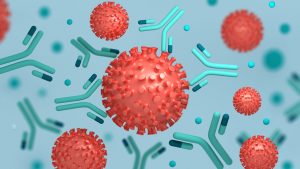Contents:
Introduction
- In most cases, interactions of antigens (Ag) with antibodies (Ab) are highly specific.
- Antibodies can distinguish between very similar antigenic molecules they can perform even stereospecific recognition of several isomeric forms of the same Ag molecule.
- Also, these interactions are extremely sensitive Ab may reveal complementary antigens in nano or picomolar concentrate molecules.
- These situations of specific Ag-Ab reactions are stimulating powerful tool in immunological chemistry for antigen or, in advert case, antibody determination.
- Taking into account that mostly any molecule may play a role of an antigen, a tremendous form of antigenic substances can be revealed.
- It was investigated with the help of serological reactions owing to another component of these reactions immune serum that contains specific antibodies.
- Antigen-antibody binding is a particular type of non-covalent interaction. Antigen and antibody molecules react by means of their active sites (epitopes vs paratopes) and form immune complexes of various structures.
- Serologic reactions can be used as: (1) by analyzing a patient’s serum for recognized antigens and (2) by identifying an individual (or other antigens) by testing for known antisera.

Some Common Properties of Serological Reactions
- They demonstrate two phases in their development. The first phase is specific. It is characterized by the recognition and binding of the complementary groups of antigens and antibodies.
- The second non-specific phase is an expanding progressive reaction that is followed by visible manifestations – at this stage, the visible complexes and aggregates are formed.
- All of these reactions occur within the electrolyte solution. Optimal pH is neutral or weakly alkaline, the optimal temperature is about 37oC.
- In some conditions at acidic (below 4.5) or alkaline pH (>9-10), or at high salt concentrations the serological reactions become reversible.
- The reversible interaction between Ag and Ab is defined by the mass action equation at the equilibrium point:
[free Ag]*[free Ab] ↔ Kd [Ag-Ab complex],
- where Kd is the dissociation constant of complex.
- As the result of the reaction (formation of the immune complex) depends on Ag and Ab concentrations, it is possible to estimate Ag or Ab quantities in serological reactions by means of known reagent (Ab or Ag).
- Therefore, in any kind of serological reaction one of the reagents, it should be determined with the help of a known second one.
- For semi-quantitative assessments of Ag or Ab amounts in serological reactions, the consecutive dilutions of reagents are used that determine the titer of an antibody or antigen.
- The limiting dilution of unknown Ab (or Ag) still able to produce the distinct positive result of the serological test is termed as the titer of antibody or antigen for this reaction.
Immune Reagents for Serological Reactions
- Immune reagents are the antibodies and antigens taking part in serological tests. For unknown antigen determination, the specific immune serum is used.
- It carries specific antibodies, which were developed after the immunization of laboratory animals (rabbit, etc.) with important antigens.
- For instance, to get the agglutinating serum, animals are immunized with a suspension of newly isolated microorganisms of a certain species or type.
- Immunization is accomplished according to a specific set of protocols, taking into account of dose and the intervals in between injections.
- At the end of immunization, blood is taken from the animals, and the serum obtained is inactivated, conserved, and titrated.
- For improvement of reaction specificity, pure specific antibodies can be isolated from sera.
The titer of agglutinating serum or antibodies
- It is also known as the smallest amount or the greatest dilution of antibodies, which causes a clearly marked agglutination reaction.
- The vials, containing the manufactured sera, carry the labels, where the titers of Abs are present, indicating the maximum dilution of serum (1/500, 1/4000, 1/16000, etc.) that may cause the agglutination of the specific antigen.
- At the time of test unknown antibodies, antigen-antigen carrying immune reagents are utilized. They are named as a group of reagents.
- The origination depends on the immunologic reaction they take part in. It can be suspended for known inactivated viruses, toxin or toxoid substance, various soluble antigenic substances.
- More complex antigenic diagnosticians are particles with originally anchored or artificially bound to their surface antigenic product (microbial and erythrocyte diagnosticums).
Tests Involved in Serological Reactions
- Hemagglutinin-inhibition tests
- Enzyme-linked immunosorbent assays (ELISAs)
- Flocculation tests
- Complement fixation
- Neutralization tests
- Radioimmunoassay (RIA)
- Chemiluminescence immunoassays
- Precipitation
- Virus neutralization
- Antitoxin neutralization
- Bacterial agglutination
- Radial immunodiffusion
- Double diffusion in agar gel
References
- https://www.sciencedirect.com/science/article/pii/B9780433101000500418
- https://mlinjawi.kau.edu.sa/Files/0001735/files/18908_LECTURE%2026%20Simple%20serological%20techniques.pdf